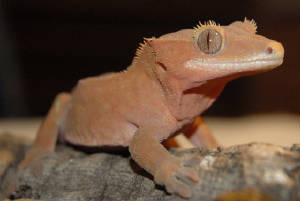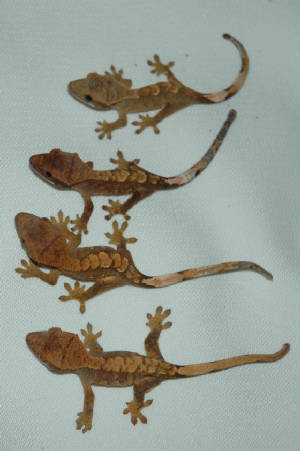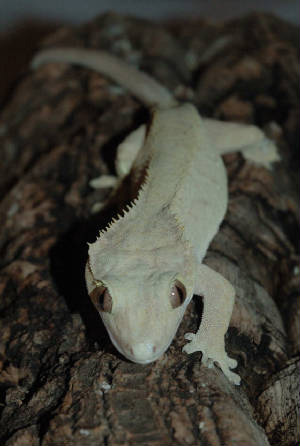Crested Gecko - Rhacodactylus ciliatus
The Crested Gecko is native to New Caledonia. It is perhaps the best pet reptile to be “discovered” in the past century. Previously thought to be extinct, numerous Crested Geckos were found happily living on several islands off of New Caledonia as well as on the mainland in the 1980’s. Since their rediscovery their captive capture and import have been ended. Not to worry however, this little reptilian clown has been produced extensively in captivity, and in color and pattern combinations that dazzle the eye and spark the imagination of even the most expert reptile keeper. Not only comical and beautiful, these little guys are extremely hardy and easy to care for! They also acclimate well to regular gentle handling and some even appear to enjoy being taken out of their cages and held.
DO NOT FEED WILD INSECTS OR INSECTS FOUND AROUND THE HOUSE – THEY MAY CARRY DISEASES THAT COULD BE DEADLY TO YOUR PET
Average Size: 7 to 9 inches (half of this being its tail)
Life Span: Over 15 years if properly cared for.
Diet: Perhaps the best part of keeping Crested Geckos is that they do not need to be fed live insects. They are an omnivorous species, which in the wild eats both insects and rotting fruits and flowers. In captivity they can be fed an excellent powdered diet produced by TRex reptile products. This diet, Crested Gecko Meal Replacement Powder (MRP), is mixed with water to make a nutritionally complete food that Crested Geckos just love! Alternatively, a fruit and meat baby food, vitamin/ mineral supplement/ honey/ spirulina/ bee pollen mix can be used in conjunction with insects such as mealworms and gutloaded, mineral powder dusted crickets. The MRP powder is both easier to use and produces better results.
Feeding: If feeding the TRex MRP solely most keepers feed either daily or every other day, leaving the dish in there for a second night. Since the Crested Gecko is nocturnal, feeding at night time just before lights out is recommended. If feeding insects with MRP, insects should be offered on alternating nights with MRP. Mealworms should be fed sparingly as they are very fibrous and can cause impactions. Crickets should not be larger than the width of the head of the smallest gecko in the tank. All crickets should be properly gutloaded and dusted with mineral powder (no phosphorous)/ vitamin supplement before feeding.
Housing: Crested Geckos can be housed in either screen or glass/ plexi enclosures. In drier areas it is recommended that glass/ plexi cages be used to provide adequate humidity. In areas with higher humidity screen cages are excellent for providing adequate ventilation. Cages should be permitted to dry out entirely during the day following a heavy night-time misting. Housing should be chosen to permit this to occur, otherwise problems with molding of the housing from too high of humidity can occur, or the animals can have retained shed due to low humidity.
 Size: Since the Crested Gecko is arboreal (lives in the trees) it strongly prefers a cage that is taller than it is long. Young geckos can be kept in small (1-2 gallon) cages until they are about 10 grams. Housing that is too large should be avoided when keeping very young geckos as they may have trouble finding their food. A single adult gecko can be housed in a 20 gallon long aquarium set up on its long end, or in a screen cage measuring 1 foot long X 1 foot deep X 2 feet high. Multiple males should NEVER be housed together as they will fight to the death. Females can be housed together, though some may have personality differences and quarrel. Overall the females seem to enjoy each others company, often being found curled up under leaves together. If males and females are housed together mating and egg laying is almost guaranteed. Juveniles should be kept in like sized groups as larger ones can and will bully smaller ones, preventing their access to food. Size: Since the Crested Gecko is arboreal (lives in the trees) it strongly prefers a cage that is taller than it is long. Young geckos can be kept in small (1-2 gallon) cages until they are about 10 grams. Housing that is too large should be avoided when keeping very young geckos as they may have trouble finding their food. A single adult gecko can be housed in a 20 gallon long aquarium set up on its long end, or in a screen cage measuring 1 foot long X 1 foot deep X 2 feet high. Multiple males should NEVER be housed together as they will fight to the death. Females can be housed together, though some may have personality differences and quarrel. Overall the females seem to enjoy each others company, often being found curled up under leaves together. If males and females are housed together mating and egg laying is almost guaranteed. Juveniles should be kept in like sized groups as larger ones can and will bully smaller ones, preventing their access to food.
Substrate: Paper towels or cage liners are by far the easiest substrate to use, though not very aesthetically pleasing. If males and females are housed together with the intent of breeding they will make finding the eggs much simpler, however. For a more pleasing set up cocofiber can be used as a substrate and planted nicely. Caution must be used if feeding insects on cocofiber however, as the geckos may ingest it when feeding. Reptile barks can also provide a nice substrate, though they carry the same risk of ingestion. NEVER use pine/ cedar chips intended for small mammals as they can make your gecko very, very ill.
Habitat: Crested Geckos love their vertical space. Bamboo poles and vertically placed cork flats will make your geckos very happy. They are also especially fond of plants, such as Pothos (which is extremely hardy),  both live and fake. The more hiding places that you give your gecko the less stressed it will be, and consequently healthier. If you are going for a sterile, easy to clean set up egg crates make excellent, though not pretty, hiding places and maximize surface areas for your geckos. both live and fake. The more hiding places that you give your gecko the less stressed it will be, and consequently healthier. If you are going for a sterile, easy to clean set up egg crates make excellent, though not pretty, hiding places and maximize surface areas for your geckos.
Grooming and Hygiene: Cresteds require very little actual grooming. Most important is to maintain adequate humidity to prevent retained sheds. In the case of a retained shed the gecko can be carefully soaked in warm water, or placed in a small plastic container (with holes punched) with damp paper towels for 30 minutes twice daily until the shed is removed. Always wash your hands before and after touching your gecko or habitat contents to help prevent Salmonella and other infectious diseases
Temperature: Crested Geckos prefer to be kept at room temperature (from 65- 80 degrees F). They experience stress at temperatures over 85 or under 65 degrees.
Lighting: As a nocturnal species your Crested Gecko will likely not come out when the lights are on, nor do they have any lighting requirements. If you are going to plant your tank a full spectrum bulb is recommended. If the house is extremely cool a 50 watt basking lamp may be used to provide a warm spot.
Water: Provide a constant supply of clean, fresh, filtered, chlorine-free water in a shallow bowl that cannot be tipped over. Using a plant mister, mist your Crested Gecko heavily twice daily. They will eagerly lap the water off of the surfaces in their enclosure, and the misting will provide much needed humidity.
Habitat Maintenance: Change water in the bowl daily; remove feces daily. Thoroughly clean the tank at least once a week.
Recommended Supplies:
- Misting bottle
- Water dish
- Food dish
- Meal Replacement Powder
- Live or fake plants
|
- Cork bark/ bamboo
- Tank/ screen enclosure with secure lid/ door
- Light, if desired
- Paper towels or Cocofiber for substrate
| Normal Behavior and Interaction: Crested Geckos are a nocturnal species that will spend all day sleeping. Once they get up in the evening they are amusing to watch wandering around their cage. They seem to enjoy each others company greatly and often sleep together during the day. At night it is not uncommon to hear the rustle of leaves during little tussles as well as growls, squeaks, barks and yips as they talk to each other in the same cage, and to geckos in other cages. Cresteds are normally amenable to handling with a little bit of patience and work. Very young animals (under three months) should be handled very little, if at all. Older juveniles and adults can be handled for as much as they tolerate, which will vary from individual to individual; some never really settle down, while others are happy to sit on a shoulder or desk for hours at a time.
Two warnings should be heeded, however. First, Crested Geckos love to jump! Animals that are not accustomed to handling should be kept close to the ground until they have lost their desire for flight. Second, if your Crested Gecko drops its tail it will never grow back (unlike many other species). These stumpy Cresteds suffer no long term negative effects, but never regain their beautiful, prehensile tails. Rough handling and overly stressing your gecko should be avoided if you want your pet to retain its caudal appendage.
Signs of a Healthy Pet:
- Active and alert
- Healthy skin
- Clear eyes
|
- Eats regularly
- Clear nose and vent
|
Common Health Issues and Red Flags:
- Weight loss or decreased appetite
- Mucus in mouth or nose
- Swelling
- Lethargy
- Bumps, sores, or abrasions on skin
- Labored breathing
|
- Paralysis of limbs or tail
- Abnormal feces
- Inability to climb
- Kinked tail
- Floppy jaw
| I would like to Thank Genevieve LaFerriere for writing this caresheet. She breeds and sells geckos, visit her website: http://www.genevievesgeckos.com
|



 Size: Since the Crested Gecko is arboreal (lives in the trees) it strongly prefers a cage that is taller than it is long. Young geckos can be kept in small (1-2 gallon) cages until they are about 10 grams. Housing that is too large should be avoided when keeping very young geckos as they may have trouble finding their food. A single adult gecko can be housed in a 20 gallon long aquarium set up on its long end, or in a screen cage measuring 1 foot long X 1 foot deep X 2 feet high. Multiple males should NEVER be housed together as they will fight to the death. Females can be housed together, though some may have personality differences and quarrel. Overall the females seem to enjoy each others company, often being found curled up under leaves together. If males and females are housed together mating and egg laying is almost guaranteed. Juveniles should be kept in like sized groups as larger ones can and will bully smaller ones, preventing their access to food.
Size: Since the Crested Gecko is arboreal (lives in the trees) it strongly prefers a cage that is taller than it is long. Young geckos can be kept in small (1-2 gallon) cages until they are about 10 grams. Housing that is too large should be avoided when keeping very young geckos as they may have trouble finding their food. A single adult gecko can be housed in a 20 gallon long aquarium set up on its long end, or in a screen cage measuring 1 foot long X 1 foot deep X 2 feet high. Multiple males should NEVER be housed together as they will fight to the death. Females can be housed together, though some may have personality differences and quarrel. Overall the females seem to enjoy each others company, often being found curled up under leaves together. If males and females are housed together mating and egg laying is almost guaranteed. Juveniles should be kept in like sized groups as larger ones can and will bully smaller ones, preventing their access to food. both live and fake. The more hiding places that you give your gecko the less stressed it will be, and consequently healthier. If you are going for a sterile, easy to clean set up egg crates make excellent, though not pretty, hiding places and maximize surface areas for your geckos.
both live and fake. The more hiding places that you give your gecko the less stressed it will be, and consequently healthier. If you are going for a sterile, easy to clean set up egg crates make excellent, though not pretty, hiding places and maximize surface areas for your geckos.